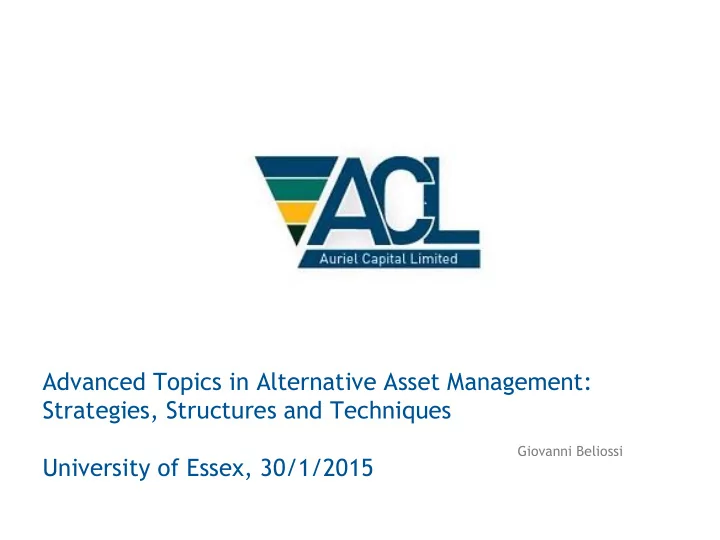

Advanced Topics in Alternative Asset Management: Strategies, Structures and Techniques Giovanni Beliossi University of Essex, 30/1/2015
Overview Advanced topics in investment management and trading • Practical • Relevant to today’s markets • Indicative of evolution of asset management business 1. Trading business structures: Hedge Funds 2. Trading strategies: Arbitrage 3. Techniques: Short Selling 4. Market Innovation: High Frequency Trading 2
Investment Management Structures and Vehicles: Hedge Funds 3
What is a Hedge Fund? Investment/trading vehicle • Often indicates on-shore management company • Typically off-shore (Cayman, BVI), or US LLP • Wider choice of trading instruments and techniques 1. Can use leverage 2. Can sell short 3. Can invest in low-quality/unrated issues 4. Typically not open to retail investors 4
Typical US Hedge Fund Setup Source: InvestoPedia 5
Hedge Fund Structures: US/Offshore Master-Feeder Source: EurekaHedge 6
Arbitrage Trading Examples 7
Statistical Arbitrage: Trade Example UK AND INTERNATIONAL MONEY RAISED BY COMPANIES (%) Source: Internal 8
Spread Convergence: Merger Arbitrage UK AND INTERNATIONAL MONEY RAISED BY COMPANIES (%) 9
Arbitrage Risk Profile: Mergers UK AND INTERNATIONAL MONEY RAISED BY COMPANIES (%) 10
Arbitrage Return Sources: Convertible Arbitrage UK AND INTERNATIONAL MONEY RAISED BY COMPANIES (%) 11
Short Selling: Concept, Techniques, Impact
Portfolio Enhancement with Short Sales UK AND INTERNATIONAL MONEY RAISED BY COMPANIES (%) Source: Merrill Lynch 13
The Mechanics of Short Selling UK AND INTERNATIONAL MONEY RAISED BY COMPANIES (%) Source: Merrill Lynch 14
Short Selling: Asymmetric Risk Profile UK AND INTERNATIONAL MONEY RAISED BY COMPANIES (%) 15
Distressed Coverage of Short-Selling Positions: Volkswagen AG Shares, October 2008 UK AND INTERNATIONAL MONEY RAISED BY COMPANIES (%) Max potential loss of long VW Stocks: -100% Max potential loss of short VW Stocks: -400% 16
Short-Selling in Distressed Situations LEHMAN VS. MERRILL LYNCH PRICE, 9/2008 • Limited supply of stock to borrow • High cost of borrow • Asymmetric payoff/risk profile • Short cover/squeeze risk ---------------------------------------- • Distressed stocks unlikely candidates for speculative short selling 17
High Frequency and Algorithmic Trading
Algorithmic Trading: A Definition • The use of electronic platforms for entering trading orders with an algorithm deciding on aspects of the order such as the timing, price, or quantity of the order, or in many cases initiating the order without human intervention Source: Wikipedia 19 19
Algorithmic Trading: Users and Providers • Widely used by pension funds, mutual funds, and other buy side (investor driven) institutional traders, to divide large trades into several smaller trades in order to manage market impact, and risk • Sell side traders, such as market makers and some hedge funds, provide liquidity to the market, generating and executing orders automatically Source: Wikipedia 20 20
Algorithmic Trading: Recent Developments • A special class of algorithmic trading is "high- frequency trading" (HFT), in which computers make elaborate decisions to initiate orders based on information that is received electronically, before human traders are capable of processing the information they observe • This has resulted in a dramatic change of the market microstructure, particularly in the way liquidity is provided. Source: Wikipedia 21 21
High-Frequency vs. Traditional Quantitative Management High Frequency Trading Traditional Quant Trading Desk/DMA Execution through algorithmic execution broker- provided “pipes” Hardware kept in-house Hardware “co - located” at exchanges Little or no overnight Holding time days to months IT-driven investment Models based on models/no fundamentals fundamental & technical High Volume per unit of Low volume per unit of capital/Low Capacity capital/High Capacity Liquidity provider Liquidity taker or provider 22
Impact of Algorithmic Trading • Smaller Trade Size • More Frequent Trading • Higher Proportion of HFT 23
High Frequency Trading: Strategies and Trade Timing Strategy Typical Holding Period • Automatic liquidity • 1 minute or less provision/synthetic M-M • Order-flow recognition • 10 minutes or less through observed quotes • Short-term trading on macro or stock-level • 1 hour or less events • Statistical Arbitrage/basis • 1 day or less trading of stocks and derivatives Source: Internal, Aldridge (2009) 24
Evolution of Bid-Ask and Liquidity During High Frequency and Algorithmic Trading Growth • Bid Ask Spread declined • Volumes Increased pre-2009 • Smaller Average Order Size Picture consistent with positive contribution of faster trading to cost reduction and market liquidity 25
Recommend
More recommend